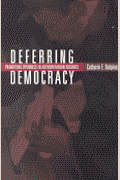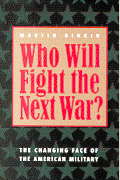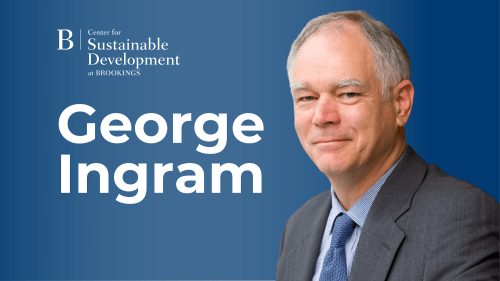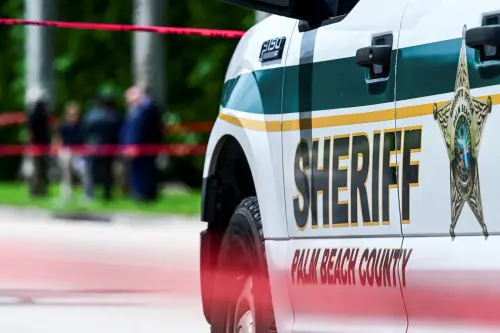The following is the introduction to “Ways to Reconcile and Heal America,” a new report by Darrell M. West.
In our history, certain events—inflection points—carry such a weight of significance that we’ll always remember where we were when they occurred.
For my parents, they could tell me exactly where they were when they learned Pearl Harbor had been bombed. My first inflection point was the assassination of President John F. Kennedy, and later, in horribly quick succession, the assassinations of Martin Luther King Jr. and Robert F. Kennedy. For my daughters, it was the attack on America on September 11, 2001. These incidents are not just historically memorable; they are watershed moments as well. Everything that followed was different. Thus it was on January 6, 2021, our most recent national inflection point. A reckless call to action from the president of the United States, Donald J. Trump, resulted in the invasion of the U.S. Capitol in an attempt to prevent the Congress from declaring the results of the 2020 presidential election. In the immediate aftermath, the president was impeached; the capital of the United States became a fortified, armed camp; and the inauguration of the 46th president occurred amidst the greatest domestic security threat in modern American history.
While others will record and analyze the minute details of this dark moment in our history, suffice to say that every aspect of it pointed to a condition of national division suspected by many, leveraged by some, and weaponized by a few; not the least being the president of the United States. For the briefest of moments, the executive branch of the U.S. government forcibly and violently unseated the legislative branch, engaged in fulfilling its constitutional duty to certify the winner of the recent presidential election. Members of the U.S. Congress fled or feared for their lives as groups of Trump’s supporters, many sporting the trappings of the Ku Klux Klan, neo Nazis, the Confederacy, and other white supremacists, forcibly breached our center of government. For hours they rampaged through the U.S. Capitol building, epicenter of American democracy, searching for the vice president and certain members of Congress to do them harm—or worse—and seeking to prevent certification of the election of Joseph R. Biden in support of Trump’s lie that the election had been stolen from him.
How could we have come to this moment? What possible convergence of deep-seated grievance, frustration, and anger could produce this moment of blinding fury? Questions with complex answers, to be sure, but what remains clear is that this was indeed an inflection point in American history. We will all remember where we were on January 6, 2021, for everything that follows will be different.
HOW WE GOT HERE
In truth, the events of the last year or so have accelerated the frustrations of enormous segments of the electorate, long suffering from the effects of economic disenfranchisement and political irrelevance. Years in the making, these frustrations have intensely polarized discussions around race, ethnicity, religion, immigration, gender, and many other sources of difference in a massively diverse society. As time progressed, the mainstream media—the usual source of unbiased reporting—was demonized and declared the “enemy of the people.” Meanwhile, social media enabled sometimes bizarre conspiracy theories; and sensational, breathless cable news cycles fanned the flames of dissatisfaction into red-hot conflagrations. The sides became radicalized; a little at first, but becoming dangerously polarized over time. Mutual respect was quickly replaced by mutual suspicion, and with the loss of respect there quickly followed the loss of civility and an alarming growth of a genuine sense of enmity; one side for the other.
Facts, too, became unmoored from truth, and the basis for constructive dialogue was lost. Political parties further ossified the differences as fewer and fewer politicians were elected based on a willingness to participate in bipartisan legislation than they were elected to defend the identity politics of their particular side seemingly at all costs. Partisan politics produced extremists and they, in turn, birthed violent extremists. And while violent white supremacists in particular had been a threat to the American population, especially to Black Americans, from the post-Civil War period onward, during the Trump administration their numbers exploded, for they had the capacity to organize, the motivation to do so, and an outspoken president whom they believed was sympathetic to their cause.
The year 2020 was thus the year the match was thrown on the fuel. This most recent breakdown began first with the COVID-19 pandemic, which in turn fostered the near collapse of the U.S. and global economies. These twin disasters accelerated and exacerbated the misery of many Americans, already badly beset by their socio-economic conditions. The president who failed to deal with the pandemic sought then to deflect blame by politicizing the response, and in so doing politically polarized the American pandemic response. What followed was the alienation of a major segment of Americans from actively participating in relief efforts and from trusting whatsoever in their government. This resulted in an ongoing yet truly unimaginable outcome: hundreds of thousands of deaths, millions infected, and an economy on the edge and more unequal and unfair than ever, especially for frontline workers, many of whom are persons of color, women, or lower-wage individuals. And yet the stark reality is that tens of millions of Americans have a very different perspective on these seemingly shared events and challenges when compared to their counterparts on the other side of the political spectrum.
Those years of pent-up differences finally played out during the campaign and in the 2020 presidential election conducted during the darkness of a lethal global pandemic. The election saw more Americans vote than ever before, and both candidates surpassed the previous record for the most votes ever received in the history of American elections. But in the end, President Trump lost, and immediately began the lie of a rigged, fraudulent, and stolen election that culminated directly, and at his behest, with the assault on the U.S. Capitol on January 6. On that day, Americans stared into the abyss of a failed state. And while no one will forget where he or she might have been at the moment of the near failure of the American experiment, most Americans are concerned with how we as a people, and the United States as a nation, can step back from the edge of the abyss and begin the national reconciliation vital to the future of America.
NATIONAL RECONCILIATION—NOW
Vitally, we, as fellow Americans, must begin to chart a path toward national reconciliation and reunification—and we must do so now. We have to arrest the downward spiral of the loss of respect and civility, and the immobilizing polarization of American politics. Efforts will have to begin first with the intentional public embrace of true healing and reconciliation by the new president and the U.S. Congress, to include announcement of a national summit on reconciliation and an open and honest discussion about what reconciliation objectives can actually entail and achieve. Words like “respect” and “civility” need to again become a part of the daily lexicon, just as bipartisanship must again become a political objective, not a sign of appeasement or shame. There’s no hope for the American experiment otherwise. And, while it may well be the most patriotic thing one can do to call out your national government when it is going astray, that’s a very different argument than actively undermining its success by confusing nationalism with patriotism. The immense responsibility placed upon our elected officials to take up the mantle of responsible leadership— to hold to our higher principles, not our worst impulses—cannot be overstated. At the same time, we must also be clear-eyed about the multifaceted and diverse nature of American society and culture, and thus the intricacies and nuance that will be required for true reconciliation. And we need to be honest about our past failures as well.
Historically, it should come as no surprise that American narratives of reconciliation and national unity are often tied back to the American Civil War and the post-war period of Reconstruction. Never were we so divided—literally or figuratively—and many efforts were made in the post-conflict era to mend the profound divisions and the great damage that was done to the country. Yet even then, those efforts focused almost exclusively on healing the white segments of the American society. Black Americans were, yet again, left nearly entirely out of the equation. Indeed, as one poignant example illustrates, on the 50th anniversary of the Battle of Gettysburg in 1913, a “festival of national reconciliation,” was held where Union and Confederate soldiers met and embraced; while Black Union veterans were not invited or held separate events. And, indeed, Black Americans across the South remained in bondage, bound by the figurative chains of Jim Crow laws. Given the tragic death of George Floyd and others in the summer of 2020, and the renewed national reckoning that followed, reconciliation going forward is necessarily and inextricably linked to the interests and the critical voices of Black, Brown, and Native communities. It’s worth repeating: these communities must be central to any viable and enduring notion of national reconciliation. No true healing can proceed without embracing this reality.
Here, we see the vast complexity of this issue, and the deep historical context of an America that has perhaps never been as united, or even as democratic, as we hoped to believe. And in this way, there will be those in society who will have no interest in reconciliation at all. Their wounds are too fresh or their hatreds and their toxic doctrines run too deep for a process of healing to truly begin. Yet for so many more, reconciliation is an entirely logical and essential sequel to the summation of their personal American experience. With that in mind, we must do what many nations and peoples around the world have already done before: listen. Listen first to the pains and struggles of those on the “other side,” and identify pathways for shared understanding and national reconciliation with those who are willing. There are, potentially, lessons from abroad that may hold some meaningful hints toward an eventual solution for American society, though the evolution of social media and a lightning-fast 24-hour news cycle certainly compound the difficulties in building trust and good faith.
Indeed, some invested in reconciliation have pointed toward the need for an official “truth and reconciliation” commission, as has been created in other countries around the world. This is a complex issue and far from a cure-all. As well, the intensity of political polarization in America makes bipartisan support for this kind of commission nearly impossible at the moment, at least one chartered by the legislature. Alternatively, commissions based outside the writ of government have sometimes worked well because they’re not as bound up in the partisan politics that often strangle bipartisanship in elected bodies. But regardless, even if a commission of some form is not established, those abroad, seeking to heal intense and painful divisions in their own countries, still have lessons from which we can learn. This is not the moment for foolish pride, for the crisis is too great and the time is too short.
Our national pain was long in the building, and so it cannot be remedied in a short time. Just being openly and publicly committed to reconciliation, and intentionally beginning the effort, is itself a tonic, but it will be a hard, emotional journey.
This will require the combined efforts of national, state, municipal, and local leadership, committed first and foremost to the goodwill to see the imperative of national reconciliation, and able to lead their respective segments of society in a genuine effort. Second, it will require patience, persistence, endurance, and the vision to see that even with the seemingly insurmountable differences at work in American society there still remains far more that unites us than divides us, and that capitalizing on these common interests and values is the best way to find a means of addressing those painful and divisive matters. And third, there must be a clear-eyed will for justice. As evidenced from the 2019 House Judiciary Committee hearings for instance, when hundreds of Black Americans gathered in the halls of the Capitol to hear of slavery reparations, there is am keen necessity to address and answer historic wrongs. More, while the term “social justice” has become politicized, its intentions offer critical pathways for accountability by dismantling structural inequities and systemic racism. We must not forget the importance of accountability on the road toward reconciliation.
In closing, on matters of reconciliation, President Abraham Lincoln is quoted frequently these days, and well he should be. A thread runs throughout his writings and his speeches that clearly pointed to his intent to engage in an effort of national reconciliation after the Civil War that would both recover our fractured Union, but also would once and for all enfranchise Black Americans, enslaved in horrendous servile labor for hundreds of years. Tragically, while shot and shell took the lives of hundreds of thousands in the Americans Civil War, the cruelest single bullet fired in the entire conflict took the life of President Lincoln, and in that moment the nation, and its people, were robbed of what might have been a new era of true national reconciliation. In his all too brief second inaugural address, we not only gain a glimpse into the mind of this great healer, but we can also find the basis to live the resolute dedication reflected in his words, even as we embark on our own journey of national healing and reconciliation:
Fondly do we hope, fervently do we pray, that this mighty scourge of war may speedily pass away. Yet, if God wills that it continue until all the wealth piled by the bondsman’s two hundred and fifty years of unrequited toil shall be sunk, and until every drop of blood drawn with the lash shall be paid by another drawn with the sword, as was said three thousand years ago, so still it must be said that the judgments of the Lord are true and righteous altogether.
With malice toward none, with charity for all, with firmness in the right, as God gives us to see the right, let us strive on to finish the work we are in, to bind up the nation’s wound, to care for him who shall have borne the battle, and for his widow and orphans; to do all which may achieve and cherish a just and lasting peace among ourselves and with all nations.
For the sake of those who have come before, and for those fellow Americans searching for a better future today, national reconciliation is the only way we can safeguard this nation—both as an idea and as a country—for all of us to enjoy as one people dedicated to the sacred proposition that all individuals are created equal.
The Brookings Institution is committed to quality, independence, and impact.
We are supported by a diverse array of funders. In line with our values and policies, each Brookings publication represents the sole views of its author(s).








Commentary
Op-edReconciling and healing America
February 8, 2021